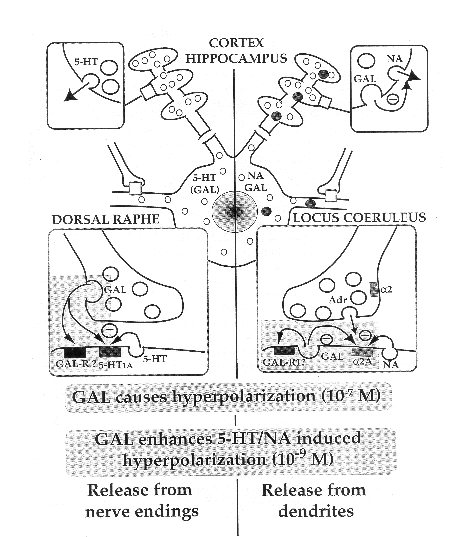
| Figure 1. |
 |
| Schematic illustration of effects of galanin on a serotoninergic dorsal raphe neuron (left panel) and a noradrenergic locus coeruleus neuron (right panel). Under normal circumstances the 5-HT neuron expresses low levels of galanin and the peptide can not be detected in cell bodies or forebrain nerve terminals. In contrast, the noradrenergic neuron has a robust galanin synthesis, and galanin can be detected in cell bodies as well as cortical and hippocampal nerve terminals. The 5-HT neurons are innervated by non-serotonergic galanin-containing boutons of unknown origin. There are comparatively few galanin nerve endings surrounding and synapsing on locus coeruleus neurons. Therefore, under normal circumstances galanin acting on 5-HT neurons may mainly originate from synaptic nerve endings in the dorsal raphe, but from dendrites and soma in the locus coeruleus. Especially under conditions when galanin synthesis is upregulated in 5-HT neurons, galanin may also in this region be released from dendrites and soma. The effect of galanin on 5-HT and noradrenaline neurons is similar, causing hyperpolarization via a direct action on a galanin receptor of not yet defined type. Somewhat higher concentrations are needed in the dorsal raphe as compared to locus coeruleus. In addition, galanin at low concentrations (10-9M) enhances the inhibitory effect of 5-HT on the 5-HT1A receptor on the 5-HT neurons and of the a2A receptor on the noradrenaline neurons. These effects, obtained at low peptide concentrations, may in fact be in the physiological range. From Ref. 61. |
published 2000